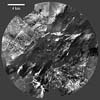| . |  |
. |
Champaign IL (SPX) Dec 06, 2005 Recent evidence from the Huygens Probe of the Cassini Mission suggests that Titan, the largest moon orbiting Saturn, is a world where rivers of liquid methane sculpt channels in continents of ice. Surface images even show gravel-sized pieces of water ice that resemble rounded stones lying in a dry riverbed on Earth. But with a surface temperature of minus 179 degrees Celsius and an atmospheric pressure 1 1/2 times that of Earth, could fluvial processes on Titan be anything like those on Earth? "The idea that rivers of methane moving chunks of ice on Titan ought to obey the same rules as rivers on Earth is not what you would assume at first," said Gary Parker, the W. H. Johnson Professor of Geology and a professor of civil and environmental engineering at the University of Illinois at Urbana-Champaign. "However, if river dynamics are truly understood at a physical level, then relations that provide reasonable results on Earth ought to provide similarly reasonable results on Titan." Parker, who has collected data from rivers all over the world, has calculated what should be key similarities and key differences between river networks on Earth and Titan. There are only three parameters that differ significantly between Earth and Titan, Parker said. First is the acceleration due to gravity - on Titan it is about one-seventh the value on Earth. Second is the viscosity of flowing fluid - the viscosity of liquid methane on Titan is about one-fifth that of water on Earth. Third is the submerged specific gravity of sediment - the value on Titan is about two-thirds of that on Earth. "What this means is that for the same discharge of liquid methane as to water, the channel characteristics on Titan should be remarkably similar to those on Earth," Parker said. "However, because of the smaller acceleration due to gravity, channel slopes on Titan should be wider, deeper and less steep than those on Earth." Wildcards that make Parker's predictions tentative include a freeze-thaw process of methane that might not be analogous to the freeze-thaw process of water on Earth, and the formation of hydrocarbons on Titan that might add a kind of cohesion not encountered on Earth. "The interaction of sunlight with a hydrocarbon rich atmosphere could possibly precipitate very sticky compounds that could give streams on Titan a degree of cohesion that makes them behave differently," Parker said. If the underlying physics has been captured correctly, Parker's correlations could be used to predict river features not just on Earth and Titan, but elsewhere as well; revealing the internal consistency of fluvial processes at work under vastly different conditions. "We are now receiving images from Mars that show relic rivers. But these analogues to what has happened on Earth are very, very old and the processes may not have been very strong," Parker said. "What is happening on Titan, however, may be every bit as active and exciting as what is happening on Earth." Parker will present his findings at the American Geophysical Union meeting in San Francisco, Dec. 5-9. Funding was provided by the National Center for Earth-surface Dynamics, a Science and Technology Center of the National Science Foundation. Related Links SpaceDaily Search SpaceDaily Subscribe To SpaceDaily Express  Ann Arbor MI (SPX) Dec 01, 2005
Ann Arbor MI (SPX) Dec 01, 2005Readings from the Huygens probe of the surface and atmosphere around Saturn's largest moon, Titan, give researchers a peek back through time to when and how Earth's atmosphere formed, and how our primitive planet looked before life took a foothold here.
|
| ||||||||||
| The content herein, unless otherwise known to be public domain, are Copyright 1995-2016 - Space Media Network. All websites are published in Australia and are solely subject to Australian law and governed by Fair Use principals for news reporting and research purposes. AFP, UPI and IANS news wire stories are copyright Agence France-Presse, United Press International and Indo-Asia News Service. ESA news reports are copyright European Space Agency. All NASA sourced material is public domain. Additional copyrights may apply in whole or part to other bona fide parties. Advertising does not imply endorsement, agreement or approval of any opinions, statements or information provided by Space Media Network on any Web page published or hosted by Space Media Network. Privacy Statement All images and articles appearing on Space Media Network have been edited or digitally altered in some way. Any requests to remove copyright material will be acted upon in a timely and appropriate manner. Any attempt to extort money from Space Media Network will be ignored and reported to Australian Law Enforcement Agencies as a potential case of financial fraud involving the use of a telephonic carriage device or postal service. |